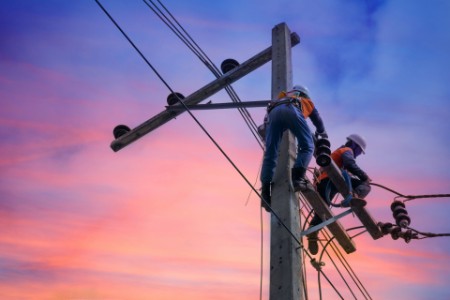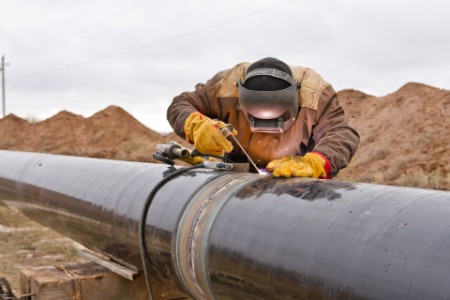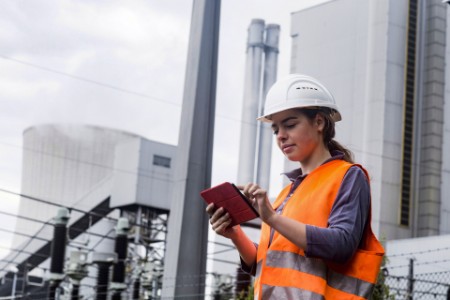
Chapter 1
Move work remotely to minimize field interaction
Digital enablement, through smartphones and specially designed apps, allows you to use fewer workers in the field and minimize handoffs.
Work out in the field can be dangerous to perform, or the risks of poor maintenance or installations can be catastrophic. Think of work on electricity equipment that must be shut off or a natural gas main that must be connected properly. Groups of workers or separate trips involving different people are required for quality control inspections and verifications, providing a necessary layer of redundancy.
Digital enablement brings greater efficiency into the equation while minimizing the need for exposing human workers to pandemic conditions, and, oftentimes, it can be as simple as using employee smartphones, without the need for extensive capital investment. Apps can be designed to easily leverage the phone’s camera to share video and upload pictures, suited for your specific needs. For instance, someone working remotely can watch over the shoulder of the person performing the maintenance, leveraging basic technology. And, as we will explore in detail later, AI technologies such as computer vision can automatically pull asset attributes and design specifications straight from the imagery.
This promotes better health and safety during a pandemic, since people would no longer need to be in proximity to each other, and exposure to other people in the typical day to day would be reduced. But it also opens up new talent strategies on which your company can capitalize.
COVID-19 forced companies to change as they focused on safety. But what you do now should be just as impactful after the pandemic. The opportunities for operational efficiencies are enormous.
For one, you can better allocate high-value work to your more seasoned and well-compensated technicians, and delegate lower-value tasks to junior staff. Do your seasoned professionals need to spend a lot of time in the van just driving to sites, or can they be leveraged remotely on more jobs? Junior staff can check in with them through video apps or even through the use of augmented reality (AR) and virtual reality technology, also used through mobile devices.
Injuries are not uncommon in this line of work, which can be physically demanding. As technicians age or need time to recuperate, your company may be putting them on light duty or assigning them more clerical tasks. But, through remote working, you can continue to call upon their skills. You also gain access to a wider talent pool, since geography is no longer a factor. Is the best person to hire far outside your service area, perhaps where the cost of living is much lower? You can complete work in New York with the know-how of technicians who work in New Mexico.
All of the above is just as true for how you interact with your customers. Many telecommunications companies today are ahead of the curve in making these possibilities a reality. Call center communications become easier when the customer can transmit photos or even video to technicians, and AR tools can be used to help the customer visualize where to plug in cables and what lights should be blinking. These technologies to reduce truck rolls out to customers in the field can save companies a significant amount in operational costs.

Chapter 2
Eliminate work through greater automation and monitoring
AI visual analytics allow you to achieve what was once impossible, and internet-enabled sensors redefine how to monitor and maintain assets.
These changes are the natural evolution of the workplace in the digital era. But the opportunities presented by AI and analytics are much broader than that. At a time when many companies are feeling financially strapped, these technologies present paradigm shifts in helping employees become more productive and driving companies to become more operationally efficient.
For instance, with handheld apps specialized for your use cases, you can gain productivity by minimizing handoffs — when a service worker in the field collects data that later needs to be inputted into a system. Understandably, companies don’t want their highly paid technicians to spend their time doing data entry, but handing it off to an administrative worker isn’t efficient, and it increases the possibility of error — and it’s another opportunity for the virus to spread. When combined with optical character recognition software and computer vision, your apps can automatically extract information, such as meter readings or measurements, right from photos and videos, so the field user doesn’t have to enter data by hand at all.
Let’s return to inspections and verifications of equipment. AI can play an enormous role here through pixel-by-pixel comparisons of photos, useful for visual verifications — the same principles behind facial recognition. A technician can take photos in the field after a job is done, and then AI-supported analytics can verify that these installations and routine maintenance have been completed properly. Positions and measurements are automatically recorded and validated through machine learning that has been trained on the specifications. That training is based on the knowledge of your human technicians, who look at photos and approve those where the work has been done properly and reject those that are improper, so that the algorithm can then take over and replicate the results with new photos from the field. Work in the field can finally focus on execution, leaving data collection and verification to technology only.
The same framework can be applied on a larger scale. You can validate utility lines just through video recording how they appear as you drive by in a car. On the back end, AI that’s been trained to recognize how a utility pole should look can determine whether human intervention is needed for repairs or maintenance. Typically, many workers fan out to do inspections of only a fraction of the poles in a given area. Now, AI is used to dramatically increase how many poles are scrutinized and flag potential problem areas for human workers to address. The “miss” rate is not eliminated entirely through technology, but, dramatically more poles can be inspected, with far fewer people.
Computer vision has broad use cases. In hospitals, it can capture inventory levels in supply closets just with an image: amounts are tallied and compared against set thresholds. In operating rooms, the technology can easily track and account for the equipment used and even compare the type listed on a bag of blood with that of the patient.
Remote monitoring can also eliminate the need for having people walking around to check on your assets. Security cameras can also be equipped to remotely detect when your assets may be overheating, for example. If you know what the regular temperature of that equipment should be, then Internet of Things (IoT) sensors, or even thermal imagery, can be used to determine when that equipment has surpassed certain thresholds. Human interventions would be needed under only certain conditions instead of potentially at any time.
AI can be coupled with IoT sensors on your asset to provide data on how it is functioning, letting you know when it is close to failing or when something is potentially wrong, without the need for periodic inspections. Data on vibrations, pressure, viscosity or other factors can be continually monitored, and, if a reading goes above or below a set threshold, a technician can be notified. This can help you move more toward predictive maintenance rather than preventive maintenance and extend the life of your assets.

Chapter 3
Adjust processes/procedures specifically for the pandemic
With greater efficiency, reducing exposure and contact becomes easier. New processes like automated material tracking can prove useful.
When you’ve enabled remote working and eliminated human involvement in work where it makes sense, the basics of minimizing exposure and contact — such as cleaning materials and workplaces — don’t need to be as broad. But companies still must confront how to receive and handle equipment in a way that’s different for field workers. You can deliver a pizza in an easily disposable box, but not a wrench or a valve.
Consider whether certain tools can stay in a certain truck instead of being passed around when they are needed to reduce the number of individual contacts. For jobs that will still require a crew of more than one person, keep the crew together more often in a common shift. Many companies use algorithms to maximize how much work can get done in a day. Now the priorities are different, so these tactics will need to be relaxed to factor in how contact can be reduced.
For those times when truck rolls out into the field are necessary, automated material tracking proves particularly useful in keeping your employees more socially distant, yet still productive. Typically, your trucks stay at a central location and are supplied with the equipment for the day ahead — but what if you wanted to dispatch people from their homes instead to minimize interaction and the potential spread of the virus? Automated material tracking is an inventory system for your technician trucks that directs workers to the jobs for which they already have the equipment on hand to complete, without having to return to the central location to resupply.
For instance, your technicians can scan barcodes as equipment is used, tracking the truck’s inventory in real time through a centralized system. Companies don’t necessarily need to invest in scanners or complex handhelds — employees can just use a smartphone app. Work can then be planned three days out, for example, matching the jobs to do with those who have all they need to complete them.
The days when field workers completed paperwork and carried cumbersome scanners can be over, today — but without AI and other technologies, companies are only scratching the surface of what’s possible.
Companies with field service workers also face a higher risk profile because their employees may interact with the general public and employees, and that creates a greater need for contact tracing. When a positive diagnosis is confirmed, companies and governments can use contact tracing to begin notifying other people with whom the worker was in close contact over a span of time. This is often enabled through Bluetooth on a device such as a smartphone, recording when such contacts took place.
"The days when field workers completed paperwork and carried cumbersome scanners can be over, today — but without AI and other technologies, companies are only scratching the surface of what’s possible," says David Bailey, Senior Manager, Enterprise Asset Management Practice, Ernst & Yong LLP.
While this technology isn’t perfect — for instance, it may register contact between two people who are, in fact, separated by a wall — it’s a prudent way to get ahead of possible liability. Imagine that one of your employees decided to go on a cruise and then infects a customer during work in the field. Has your company been negligent? Apps can also be used to validate entry to offices and warehouses, placing the onus on your workforce to confirm, through a series of questions, that they do not have symptoms of the virus and have not participated in travel or other high-risk behaviors.
In a time of deep uncertainty, it is hard to make bets on where your industry is headed, or what your customers will demand. But smarter and more cost-effective ways of working, through digital enablement and automation, provide you with an immediate advantage that helps address your short-term challenges while also positioning you for future success. Now is the time to reimagine not only what you do, but how you do it — not because the pandemic demands it, but because it makes your organization stronger long after social distancing becomes a forgotten buzzword.
David Bailey, Senior Manager, Enterprise Asset Management Practice, Ernst & Young LLP, contributed to this article.
Summary
Digitization, mobile enablement and intelligent automation offer new, sustainable ways to minimize human contact without negatively affecting customer satisfaction. Emerging technologies allow you to rethink what your workers do and how they do it, and, while COVID-19 will pass, these operational efficiencies will have staying power.


